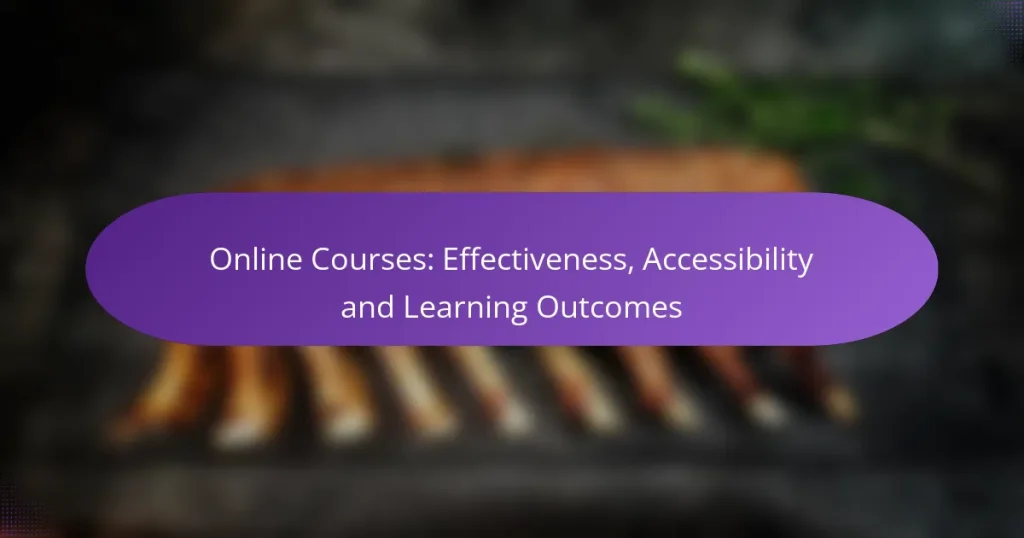Online courses have emerged as a powerful alternative to traditional education, providing flexibility and accessibility that cater to a wide range of learners. With their ability to accommodate diverse learning styles and deliver significant knowledge gains, these courses are increasingly popular among students seeking convenient and effective educational experiences.

How Effective Are Online Courses for Learning?
Online courses are generally effective for learning, offering flexibility and accessibility that traditional classrooms may lack. They can lead to significant knowledge gains and cater to diverse learning styles, making them a popular choice for many learners.
High completion rates
Many online courses report completion rates that can vary widely, often ranging from 20% to 80%. Factors influencing these rates include course design, engagement strategies, and the support provided to learners. Well-structured courses with interactive elements tend to see higher completion rates.
To improve completion rates, course providers should focus on creating engaging content and fostering a sense of community among participants. Regular check-ins and reminders can also help keep learners motivated.
Improved knowledge retention
Online courses can enhance knowledge retention through varied instructional methods, such as video lectures, quizzes, and interactive assignments. Studies suggest that learners often retain information better when they engage with content actively rather than passively.
Incorporating spaced repetition and self-assessment tools can further boost retention. For instance, quizzes spaced over time can help reinforce learning and ensure that information is not quickly forgotten.
Flexible learning pace
One of the primary advantages of online courses is the ability to learn at one’s own pace. This flexibility allows learners to spend more time on challenging topics while moving quickly through familiar material. Many platforms offer features that enable learners to pause, rewind, or revisit lessons as needed.
However, self-paced learning requires discipline and time management skills. Setting personal deadlines and creating a study schedule can help maintain progress and prevent procrastination.

What Makes Online Courses Accessible?
Online courses are accessible due to their wide availability, affordability, and adaptability to various devices. These factors enable learners from diverse backgrounds to engage with educational content at their convenience.
Availability of diverse platforms
Numerous online learning platforms cater to different subjects and learning styles, such as Coursera, Udemy, and edX. Each platform offers unique features, including video lectures, interactive quizzes, and peer discussions, allowing learners to choose what best suits their needs.
When selecting a platform, consider factors like course variety, user interface, and community support. This diversity ensures that learners can find courses that align with their interests and learning preferences.
Affordability of course options
Many online courses are available at low or no cost, making education more accessible to a broader audience. Platforms often offer free courses, while paid options typically range from a few dollars to several hundred, depending on the course depth and certification.
Look for scholarships or financial aid options if you encounter high fees. Many institutions provide discounts or free trials, allowing you to explore courses without committing financially.
Mobile-friendly learning environments
Mobile-friendly platforms enable learners to access courses on smartphones and tablets, enhancing flexibility. This accessibility allows users to learn on-the-go, fitting education into their busy schedules.
When choosing a course, verify that the platform has a responsive design or a dedicated app. This ensures a smooth learning experience, whether you’re at home or commuting.

How Do Online Courses Compare to Traditional Learning?
Online courses offer a flexible alternative to traditional learning, often allowing for greater accessibility and varied learning experiences. While both methods have their strengths, the effectiveness of online courses can depend on individual learning styles and specific course design.
Cost-effectiveness
Online courses typically present a more cost-effective option compared to traditional education. Tuition fees for online programs often range from a few hundred to a few thousand dollars, significantly lower than the costs associated with in-person classes, which can include transportation, housing, and materials.
Additionally, many online platforms offer free or low-cost courses, making education accessible to a wider audience. When considering the total cost, students should factor in potential savings on commuting and accommodation.
Learning outcomes comparison
Research indicates that learning outcomes from online courses can be comparable to those from traditional classrooms, provided the online courses are well-structured. Students who engage actively with the material and participate in discussions often achieve similar or even better results than their peers in traditional settings.
However, the effectiveness can vary based on the subject matter and the student’s motivation. For instance, hands-on fields may benefit more from in-person instruction, while theoretical subjects can be effectively taught online.
Student engagement levels
Student engagement in online courses can be a challenge due to the lack of physical presence and direct interaction. However, many online programs incorporate interactive elements such as discussion forums, quizzes, and video conferencing to enhance participation.
To improve engagement, students should seek courses that emphasize collaboration and provide opportunities for real-time interaction. Setting personal goals and creating a dedicated study environment can also help maintain motivation and focus throughout the course.

What Are the Best Platforms for Online Courses?
The best platforms for online courses include Coursera, Udemy, and edX, each catering to different learning needs. These platforms offer a range of courses, from professional development to skill-based learning and academic subjects, making them suitable for various learners.
Coursera for professional development
Coursera is ideal for those seeking professional development through courses offered by top universities and companies. Users can enroll in specializations or professional certificates that enhance their skills in specific fields, such as data science or project management.
Consider the flexibility of course schedules and the potential for financial aid, which can make high-quality education more accessible. Many courses also offer a free audit option, allowing learners to explore content before committing financially.
Udemy for skill-based learning
Udemy focuses on skill-based learning, offering a vast library of courses on topics ranging from programming to photography. The platform allows instructors to create and sell courses, resulting in a diverse range of content and teaching styles.
When choosing courses on Udemy, look for user ratings and reviews to gauge quality. Frequent discounts can make courses affordable, often ranging from $10 to $20 during sales, making it a budget-friendly option for learners.
edX for academic courses
edX provides access to academic courses from prestigious institutions, making it suitable for learners interested in formal education. Many courses offer the option to earn verified certificates or even credit towards a degree.
Be aware that while some courses are free to audit, obtaining a certificate typically requires a fee. edX also features MicroMasters programs, which can be a stepping stone towards a full master’s degree, appealing to those looking for advanced education.

What Factors Influence Learning Outcomes in Online Courses?
Learning outcomes in online courses are influenced by several key factors, including instructor quality, course design, and opportunities for peer interaction. Understanding these elements can significantly enhance the effectiveness of online education.
Instructor quality
The quality of the instructor plays a crucial role in determining learning outcomes in online courses. An effective instructor not only possesses subject matter expertise but also engages students through clear communication and supportive feedback. Instructors who are responsive and approachable can foster a more conducive learning environment.
When evaluating an online course, consider the instructor’s qualifications, teaching style, and student reviews. Courses led by experienced educators often yield better engagement and retention rates, enhancing overall learning effectiveness.
Course design and interactivity
Well-structured course design and interactivity are vital for successful online learning. Courses that incorporate multimedia elements, such as videos, quizzes, and interactive assignments, tend to keep learners engaged and motivated. A good design should also provide clear learning objectives and a logical progression of content.
To maximize learning outcomes, look for courses that offer a variety of interactive components. For instance, courses that include discussion forums or hands-on projects can significantly improve comprehension and application of knowledge.
Peer interaction opportunities
Opportunities for peer interaction can greatly enhance the learning experience in online courses. Collaborative activities, such as group projects or peer reviews, allow students to share insights and learn from one another. This social aspect can lead to a deeper understanding of the material and a sense of community among learners.
When selecting an online course, consider the level of peer interaction it offers. Courses that encourage networking and collaboration often lead to higher satisfaction and better learning outcomes, as students feel more connected and supported throughout their educational journey.


